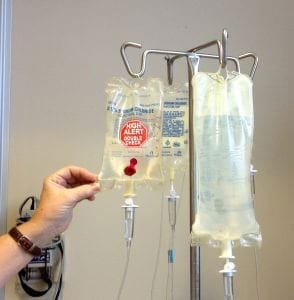Dr. Richard Stone recently interviewed with Targeted Oncology to discuss challenging acute myeloid leukemia subtypes and a list of available therapies.
Dr. Stone was asked to look back at progress in treating leukemia over the past five years. He explained that over the last decade, patients at any age were treated with a regimen of three days dosed with daunorubicin or idarubicin and seven days of cytarabine.
About APL
The only exception surfaced twenty-five years ago with the identification of acute promyelocytic leukemia [APL]. Ten percent of patients with this APML subtype have a ninety percent chance of being cured by using retinoic acid combined with arsenic trioxide.
This leaves the other ninety percent searching for better options.
Eight New Drugs for AML in the Last Four Years
It was not until recently that encouraging results were brought forward from trials of older patients who were ineligible for stem cell transplants or the 7/3 regimen.
The options used for these patients were hypomethylating drugs such as azacitidine (Vidaza) and decitibine (Dacogen). Methylation detoxifies toxins in the cell and repairs DNA damage.
Previously AML was treated as “one disease.” It was not until recently that a better understanding of AML led to identifying subtypes. At the same time, about eight new drugs for AML were FDA approved.
The 7/3 regimen is still in use, but it has undergone several changes. One example is a patient with core-binding factor AML which is a form of cancer of the bone marrow. This patient will still be treated with the 7/3 regimen but gemtuzumab ozogamicin [Mylotarg] will be added.
Then there is another option. When a patient is diagnosed with FLT3 which is a mutated AML the patient will be prescribed the 7/3 regimen but also midostaurin (Rydapt) if they are strong enough to withstand chemotherapy.
Other categories involve patients with therapy-related AML or AML that evolved after myelodysplastic syndromes commonly known as MDS. One in three patients with MDS may progress to AML. These patients might receive an alternate type of 7/3 called CPX-351.
About CPX-351
CPX-351 encapsulates cytarabine and daunorubicin into leukemia cells in a greater quantity than in bone marrow cells. Previous clinical studies showed prolonged survival as compared to the 7/3 regimen. The patients studied were older patients newly diagnosed with secondary AML that originated from MDS or a condition that converts to AML.
Note that patients who are over the age of 75 or who have other disorders are usually disqualified as 7/3 candidates. These patients should receive a hypomethylating agent, namely azacitidine, together with the BCL-2 inhibitor venetoclax (Venclexta).
New Strategies
One of the newer strategies being explored is associated with induction (initial treatment) therapy. Researchers are studying several approaches to patients with targeted mutations. Should they be treated with:
- Azacitidine and venetoclax, or
- A targeted drug plus venetocax, or
- The targeted drug plus venetoclax and azacitidine
Dr. Stone said that the latter are called triplets and have received a great deal of interest.
About IDH1 and IDH2
IDH1 and IDH2 mutations occur in eight to twelve percent respectively of AML patients. Dr. Stone explained that these mutations can be targeted with an IDH1 inhibitor called Tibsovo (ivosidenib) and IDH2 inhibitor Idhifa (enasidenib.)
But the story does not end here. Now researchers are considering whether these drugs can be utilized during the early stages by using one or all of the aforementioned three options. They are considering the options not only for the IDH mutants but also for the FLT3 mutation
Dr. Stone listed the following as key options:
- P53 specific drugs
- Anti-CD47 agents
- IDH1 and IDH2 inhibitors
Scientists are Studying New Targeted Therapies for AML
According to Dr. Stone, the optimal targets are mutations that are found on leukemic cells only and not on normal cells such as FLT3, ITD, and TKD mutations.
A specific protein that sits on the surface of DNA is called menin, a targeted inhibitor. It does not directly inhibit the mutation but does inhibit a target relevant to patients with that type of mutation.
Then Dr. Stone listed the subtypes that can be treated with any one of the menin inhibitors and either chemotherapy or an inhibitor plus low-dose chemotherapy. These subtypes are FLT3, IDH1 and IDH2, C-Kit, TP53, and menin.
Key Unmet Needs
To conclude the discussion, Dr. Stone spoke about key unmet needs starting with the TP53 mutant AML which he describes as a devastating disease. TP53 accounts for approximately fifteen percent of AML cases. It is incurable for patients who have had a transplant.
Dr. Stone also mentioned the need to improve the relapse and cure rates for older patients.








